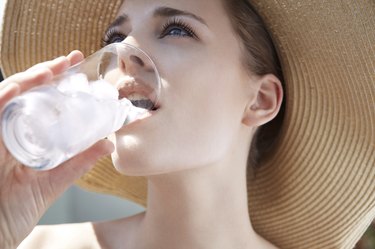
Drinking plenty of fluids is important in order to stay hydrated and healthy. But you might also have seen reports that drinking ice-cold water increases metabolism. So what's the idea behind this theory and is there any truth to it?
Tip
Ice-cold water increases metabolism ever so slightly, as some calories are burned bringing it up to body temperature. But the effect is too small to have any bearing on your weight.
Video of the Day
Why Water and How Much?
According to the Centers for Disease Control and Prevention (CDC), water is vital for the following:
Video of the Day
- Regulating body temperature.
- Keeping your joints lubricated.
- Getting rid of toxins via sweat, urine and bowel movements.
There are no official guidelines for intake of water, but experts at the National Academies of Science, Engineering and Medicine estimate that most women who are adequately hydrated consume an average of 2.7 liters (11.5 cups) of total water daily. Men who are adequately hydrated drink approximately 3.7 liters (15.5 cups) daily.
Bear in mind that this is the total from all beverages and foods. Around 80 percent of your fluid intake comes from beverages, and 20 percent comes from high-water foods such as fruits, salads and soups.
Although water is the ideal drink, other fluids also provide hydration, according to the Mayo Clinic. For example, milk, juice and herbal tea all count toward your fluid intake. Sugary drinks also count, but are best avoided, especially if you're watching your weight, advises the CDC. Swapping a 20-ounce sugar-sweetened soda for a glass of water will save you about 240 calories.
Water and Your Weight
Besides being calorie-free, water offers other waistline benefits. Research published in the July/August 2016 issue of the Annals of Family Medicine found that people who are better hydrated are less likely to develop obesity. This research can't prove that drinking more will make you slimmer, but it is an interesting correlation.
It's certainly a good idea to drink a glass of water when you're hit by a food craving, as evidence suggests that people often wrongly interpret thirst as hunger. In a one-off classic study in the August 2008 issue of Physiology & Behavior, study subjects responded "appropriately" by consuming water when they were thirsty (but not hungry) only 2 percent of the time.
To keep water slimming but interesting, the Harvard T.H. Chan School of Public Health suggests infusing it with low-calorie flavor options such as slices of lemon or lime, crushed raspberries, mint leaves or slivers of ginger root and cucumber.
Read more: Sparkling Water Versus Regular Water
Cold Water Metabolism Myth
Adding plenty of ice cubes is another way to make water nicer to drink. In theory, there's also an extra waistline benefit to drinking cold water, because your body has to bring the water up to your body temperature, which takes energy.
However, the calorie advantage of drinking super-chilled water is actually quite small. According to the University of Washington, you'll burn only 8 calories more per cup by drinking water at just above freezing, rather than at room temperature. If you drank 8 cups of iced water a day, you'd burn off just 68 extra calories.
By all means, take advantage of how ice-cold water increases metabolism a tiny bit, especially in the middle of summer, when it's appealing to do so anyway. However, the rest of the time, just enjoy warmer drinks if you prefer — staying hydrated is your primary objective, which means enjoying as many drinks as you need at a temperature that works for you.
It's also worth noting that 15 minutes of walking burns around 68 calories for the average person according to the CDC. So drink your water at a temperature you enjoy and try to stay active.
- University of Washington: "Water Myths Debunked"
- Centers for Disease Control and Prevention: "Physical Activity for a Healthy Weight"
- Centers for Disease Control and Prevention: "Water and Nutrition"
- National Academies of Science, Engineering and Medicine: "Report Sets Dietary Intake Levels for Water, Salt, and Potassium to Maintain Health and Reduce Chronic Disease Risk"
- Mayo Clinic: "Water: How Much Should You Drink Every Day?"
- Annals of Family Medicine: "Inadequate Hydration, BMI, and Obesity Among US Adults: NHANES 2009-2012"
- Physiology & Behavior: "Relationships Between Human Thirst, Hunger, Drinking, and Feeding"
- Harvard T.H. Chan School of Public Health: "Water"